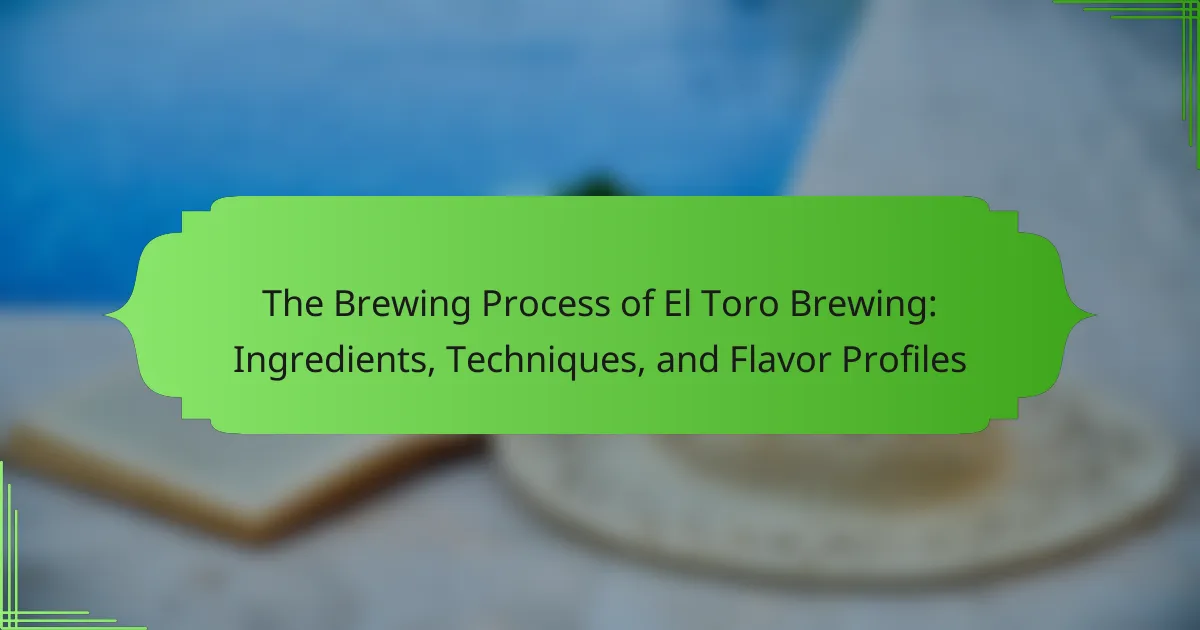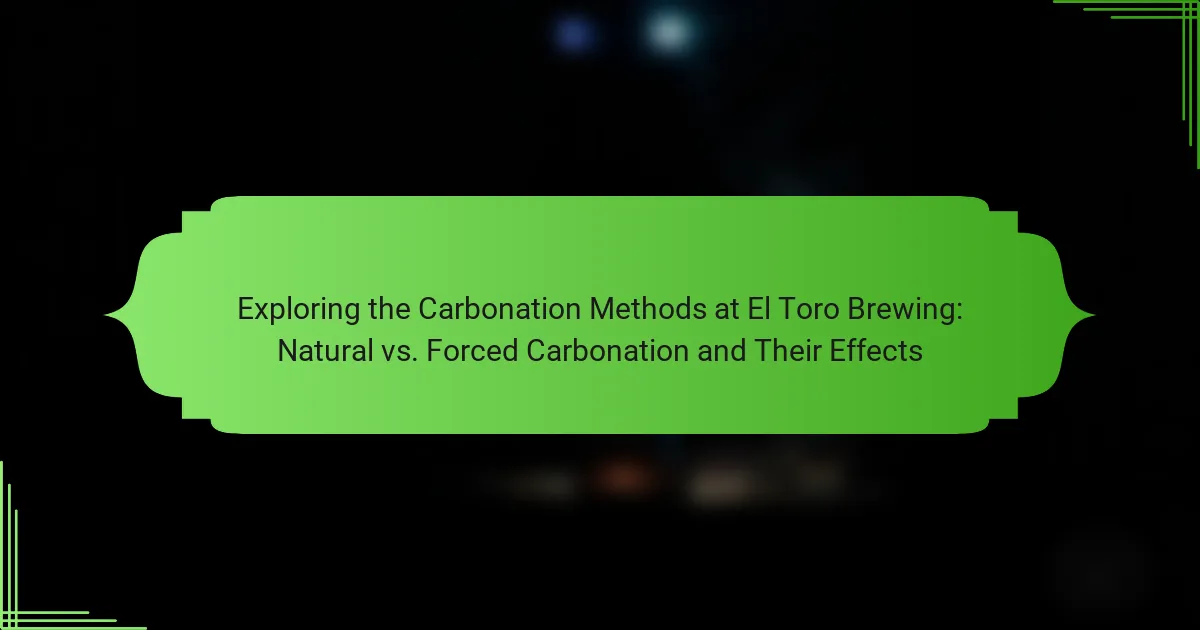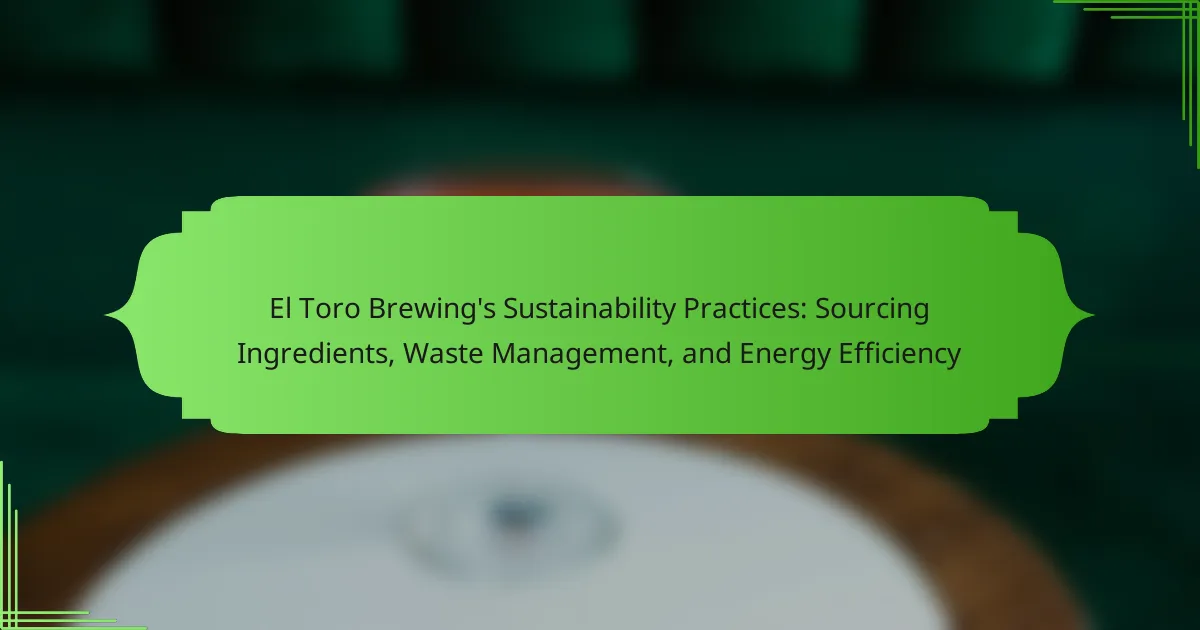El Toro Brewing specializes in crafting high-quality beer through a meticulous brewing process. The process begins with the selection of essential ingredients: malt, hops, yeast, and water. Key stages include mashing to extract sugars, boiling to incorporate hops, and cooling the wort for fermentation, where yeast is added. After fermentation, the beer undergoes conditioning to enhance flavor before being filtered and packaged for distribution. Each step is monitored to ensure the final product maintains consistent quality and flavor profiles.

What is the Brewing Process of El Toro Brewing?
El Toro Brewing’s brewing process involves several key stages. First, they select high-quality ingredients, including malt, hops, yeast, and water. The process begins with mashing, where malt is mixed with hot water to extract sugars. This mixture is then boiled, and hops are added for bitterness and aroma. After boiling, the wort is cooled rapidly to prepare for fermentation. Yeast is introduced to the cooled wort, initiating fermentation. This stage can last from several days to weeks, depending on the beer style. Once fermentation is complete, the beer is conditioned, allowing flavors to mature. Finally, the beer is filtered and packaged for distribution. Each step is carefully monitored to ensure quality and consistency in flavor.
How does the brewing process influence the final product?
The brewing process significantly influences the final product’s flavor, aroma, and mouthfeel. Key steps include mashing, boiling, fermentation, and conditioning. During mashing, enzymes convert starches into sugars, impacting sweetness. Boiling sterilizes the wort and extracts flavors from hops, contributing bitterness and aroma. Fermentation transforms sugars into alcohol and carbon dioxide, defining the beverage’s strength and effervescence. Conditioning allows flavors to meld and mature, enhancing complexity. Each step’s temperature and duration can further modify the final product’s characteristics. For instance, higher fermentation temperatures may produce fruity esters, while lower temperatures yield cleaner profiles.
What are the key stages in the brewing process?
The key stages in the brewing process are mashing, boiling, fermenting, conditioning, and packaging. Mashing involves mixing crushed grains with hot water to extract sugars. This process typically lasts for one to two hours. Boiling follows mashing and lasts about an hour. During boiling, hops are added for bitterness and aroma. Fermenting occurs after boiling, where yeast is introduced to convert sugars into alcohol. This stage can take several days to weeks. Conditioning is the next stage, allowing flavors to mature and carbonation to develop. Finally, packaging involves transferring the beer into bottles, cans, or kegs for distribution. Each stage is crucial for producing quality beer.
How do different techniques affect the brewing outcome?
Different brewing techniques significantly influence the final outcome of the brew. Techniques such as steeping time, temperature control, and fermentation methods alter flavor, aroma, and clarity. For instance, longer steeping times extract more flavors from ingredients. Higher temperatures can enhance extraction but may also lead to undesirable bitterness. Yeast strain selection affects fermentation speed and flavor profile. Additionally, techniques like dry hopping introduce aromatic compounds without adding bitterness. Each technique’s specific application results in distinct taste experiences. Understanding these effects allows brewers to craft desired flavor profiles effectively.
What ingredients are essential in El Toro Brewing?
El Toro Brewing primarily uses water, malted barley, hops, and yeast in its brewing process. Water serves as the base for all beer. Malted barley provides fermentable sugars and contributes to the beer’s flavor and color. Hops add bitterness, aroma, and stability to the beer. Yeast is essential for fermentation, converting sugars into alcohol and carbon dioxide. Each ingredient plays a critical role in achieving the desired flavor profile and quality of the final product.
Which types of malt are used in the brewing process?
The types of malt used in the brewing process include pale malt, caramel malt, and roasted malt. Pale malt serves as the base malt for most beers, providing fermentable sugars. Caramel malt adds sweetness and color, enhancing the beer’s flavor profile. Roasted malt contributes dark colors and rich flavors, often found in stouts and porters. Each malt type plays a crucial role in defining the characteristics of the final product. The combination of these malts allows brewers to create a wide range of beer styles.
What role do hops play in flavor development?
Hops are crucial in flavor development during the brewing process. They contribute bitterness, aroma, and flavor to beer. The bitterness from hops balances the sweetness of malt. This balance is essential for a well-rounded beer profile. Hops also impart various aromas and flavors ranging from floral to citrus. Different hop varieties can significantly influence the final taste. For example, Cascade hops provide grapefruit notes, while Saaz hops offer earthy characteristics. The timing of hop additions during brewing affects the flavor profile. Early additions enhance bitterness, while late additions boost aroma and flavor.
How does water quality impact the brewing process?
Water quality significantly impacts the brewing process. It affects the extraction of flavors, aromas, and the overall balance of the beer. Different minerals in water, such as calcium, magnesium, and sulfate, influence the brewing chemistry. For example, calcium enhances enzyme activity and promotes yeast health. Magnesium contributes to the flavor profile and aids fermentation. Sulfate can accentuate hop bitterness, while chloride can enhance malt sweetness. High levels of chlorine or chloramine can lead to off-flavors in the final product. Consistent water quality ensures repeatability in brewing, allowing brewers to produce the same flavor profiles across batches. Thus, understanding and controlling water quality is essential for achieving desired beer characteristics.
What techniques are employed in El Toro Brewing?
El Toro Brewing employs several techniques in its brewing process. These include traditional fermentation methods and innovative brewing technologies. The brewery utilizes a combination of natural ingredients and precise temperature control. They focus on quality by sourcing local hops and malts. El Toro Brewing also practices barrel aging for certain beer styles. This technique enhances flavor complexity and adds unique characteristics. Additionally, they implement dry hopping to intensify aroma without increasing bitterness. These techniques contribute to the distinctive flavor profiles of their beers.
How does fermentation contribute to flavor profiles?
Fermentation significantly contributes to flavor profiles by transforming sugars into alcohol and carbon dioxide through yeast activity. During this process, yeast also produces various compounds such as esters and phenols. These compounds are responsible for fruity and spicy flavors in the final product. For instance, esters can impart banana or apple notes, while phenols may add clove or smoky characteristics. The specific strains of yeast used can further influence the flavor profile. Different fermentation temperatures can also alter the production of these flavor compounds. Ultimately, fermentation is essential for developing the unique taste of each brew.
What is the significance of temperature control during brewing?
Temperature control during brewing is crucial for achieving the desired flavor and quality of the final product. It affects the extraction of flavors and aromas from the ingredients. Different temperatures can enhance or suppress specific compounds. For instance, higher temperatures can lead to over-extraction, resulting in bitterness. Conversely, lower temperatures may under-extract, leading to a flat taste. Studies show that optimal brewing temperatures range from 150°F to 170°F for most styles. Maintaining this range ensures the right balance of sweetness and bitterness. Accurate temperature control also influences fermentation, impacting yeast activity and overall alcohol content. Therefore, precise temperature management is essential for producing high-quality beer.
What flavor profiles can be expected from El Toro Brewing?
El Toro Brewing offers a diverse range of flavor profiles. Their beers typically feature fruity, hoppy, and malty notes. Common flavors include citrus, pine, and caramel. Some brews exhibit chocolate or coffee undertones. The use of various hops enhances bitterness and aroma. El Toro Brewing often incorporates seasonal ingredients for unique seasonal flavors. Their approach results in a well-rounded tasting experience. Each beer showcases a balance between sweetness and bitterness.
How do the ingredients influence flavor characteristics?
Ingredients directly influence flavor characteristics by providing distinct tastes and aromas. Each ingredient contributes specific compounds that shape the final flavor profile. For example, malted grains add sweetness and body through sugars and caramelization. Hops introduce bitterness and aromatic qualities, balancing the sweetness of the malt. Yeast plays a crucial role in fermentation, producing esters and phenols that add fruity or spicy notes. Water chemistry affects the overall flavor, with mineral content influencing bitterness and mouthfeel. Different varieties and combinations of these ingredients create unique flavor experiences. The specific ratios and methods of combining ingredients further refine these characteristics, allowing for a diverse range of flavors in the final brew.
What are the unique flavor notes found in El Toro beers?
El Toro beers are known for their unique flavor notes that include citrus, caramel, and toasty malt. The citrus notes often come from the hops used in the brewing process. These hops contribute a bright, refreshing quality to the beer. Caramel flavors are typically derived from the malt, providing a sweet undertone. Toasty malt adds depth and complexity to the overall taste profile. Each of these flavor notes is carefully balanced to create a distinctive experience for the drinker. The combination of these elements showcases the craftsmanship behind El Toro beers.
How does the brewing process of El Toro Brewing compare to other breweries?
El Toro Brewing employs a unique brewing process that emphasizes traditional techniques and local ingredients. Their method includes small-batch brewing, which allows for greater control over flavor and quality. Many other breweries use larger, more automated systems that may compromise on these aspects. El Toro Brewing’s focus on fresh, locally sourced ingredients enhances the distinctiveness of their beers. This approach contrasts with some breweries that prioritize efficiency over ingredient quality. Additionally, El Toro Brewing often experiments with unique flavor profiles, setting them apart from more conventional breweries. Their commitment to craft brewing is evident in their meticulous attention to detail throughout the brewing process.
What distinguishes El Toro Brewing’s techniques from traditional methods?
El Toro Brewing distinguishes its techniques from traditional methods through innovative fermentation processes. They utilize a unique temperature-controlled fermentation system. This allows for precise management of yeast activity. Traditional methods often rely on ambient temperatures, which can lead to inconsistent results. El Toro Brewing also incorporates experimental ingredients, enhancing flavor profiles. This approach contrasts with conventional recipes that adhere strictly to established ingredients. Additionally, their use of advanced filtration techniques ensures clarity and stability. These methods reflect a commitment to quality and creativity in brewing.
What best practices should homebrewers consider when replicating El Toro Brewing’s process?
Homebrewers should prioritize ingredient quality when replicating El Toro Brewing’s process. Using fresh, high-quality ingredients enhances flavor and aroma. Accurate measurements of malt, hops, and water are crucial for consistency. Temperature control during fermentation affects yeast activity and flavor profiles. Maintaining sanitation throughout the brewing process prevents contamination. Regularly tasting samples during fermentation helps monitor progress and adjust as needed. Documenting each batch provides valuable insights for future brewing sessions. Following these best practices can lead to successful replication of El Toro Brewing’s unique flavors.
The main entity of the article is El Toro Brewing, which focuses on its brewing process, ingredients, techniques, and flavor profiles. The article outlines the key stages of brewing, including mashing, boiling, fermentation, conditioning, and packaging, emphasizing how each step influences the final product’s flavor, aroma, and mouthfeel. It details essential ingredients such as malted barley, hops, and yeast, and discusses the impact of water quality and various brewing techniques on flavor development. Additionally, the article highlights the unique flavor notes found in El Toro beers and compares their brewing process to that of other breweries, showcasing their commitment to quality and craftsmanship.


